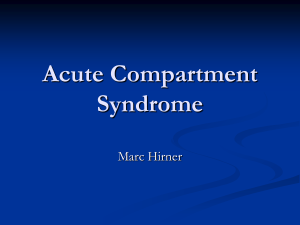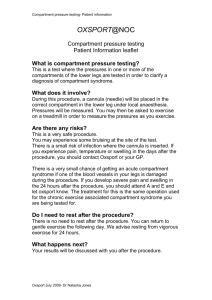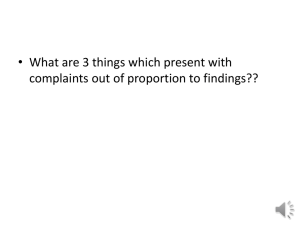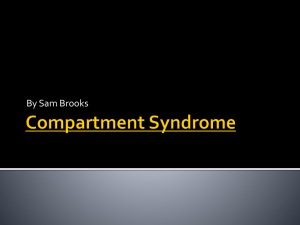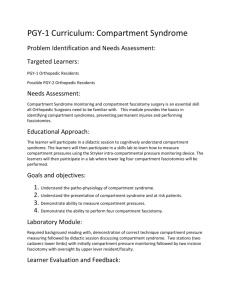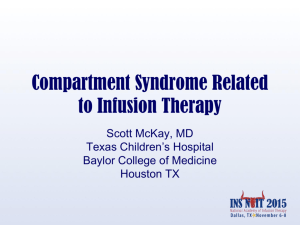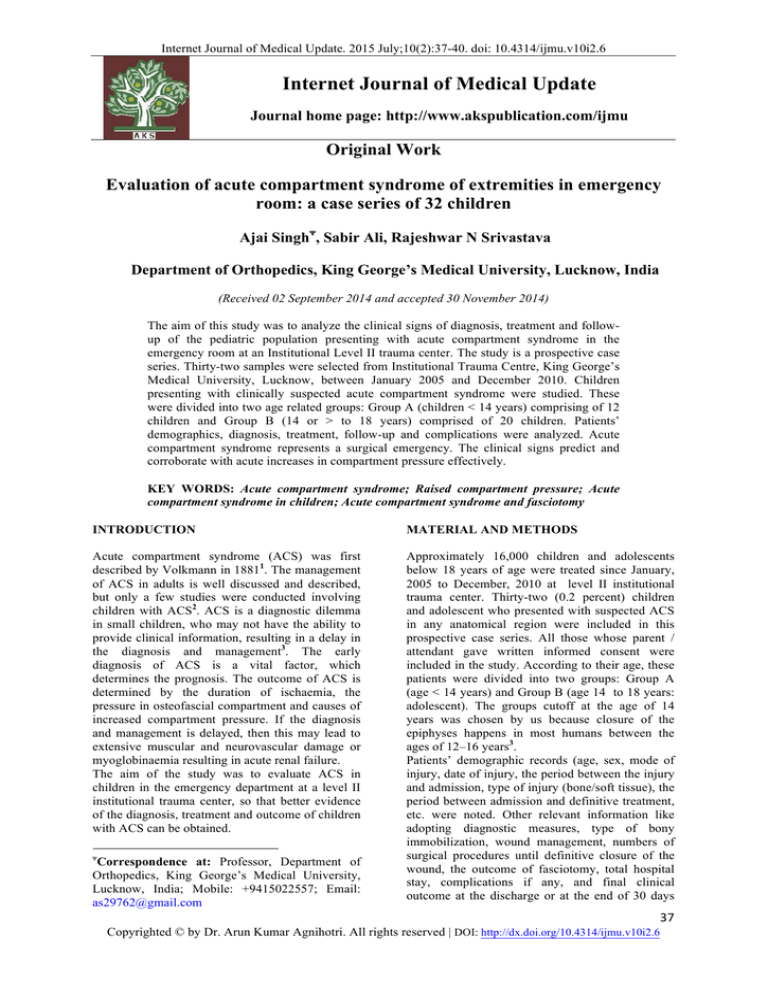
Internet Journal of Medical Update. 2015 July;10(2):37-40. doi: 10.4314/ijmu.v10i2.6
Internet Journal of Medical Update
Journal home page: http://www.akspublication.com/ijmu
Original Work
Evaluation of acute compartment syndrome of extremities in emergency
room: a case series of 32 children
Ajai Singhᴪ, Sabir Ali, Rajeshwar N Srivastava
Department of Orthopedics, King George’s Medical University, Lucknow, India
(Received 02 September 2014 and accepted 30 November 2014)
The aim of this study was to analyze the clinical signs of diagnosis, treatment and followup of the pediatric population presenting with acute compartment syndrome in the
emergency room at an Institutional Level II trauma center. The study is a prospective case
series. Thirty-two samples were selected from Institutional Trauma Centre, King George’s
Medical University, Lucknow, between January 2005 and December 2010. Children
presenting with clinically suspected acute compartment syndrome were studied. These
were divided into two age related groups: Group A (children < 14 years) comprising of 12
children and Group B (14 or > to 18 years) comprised of 20 children. Patients’
demographics, diagnosis, treatment, follow-up and complications were analyzed. Acute
compartment syndrome represents a surgical emergency. The clinical signs predict and
corroborate with acute increases in compartment pressure effectively.
KEY WORDS: Acute compartment syndrome; Raised compartment pressure; Acute
compartment syndrome in children; Acute compartment syndrome and fasciotomy
INTRODUCTIONᴪ
MATERIAL AND METHODS
Acute compartment syndrome (ACS) was first
described by Volkmann in 18811. The management
of ACS in adults is well discussed and described,
but only a few studies were conducted involving
children with ACS2. ACS is a diagnostic dilemma
in small children, who may not have the ability to
provide clinical information, resulting in a delay in
the diagnosis and management3. The early
diagnosis of ACS is a vital factor, which
determines the prognosis. The outcome of ACS is
determined by the duration of ischaemia, the
pressure in osteofascial compartment and causes of
increased compartment pressure. If the diagnosis
and management is delayed, then this may lead to
extensive muscular and neurovascular damage or
myoglobinaemia resulting in acute renal failure.
The aim of the study was to evaluate ACS in
children in the emergency department at a level II
institutional trauma center, so that better evidence
of the diagnosis, treatment and outcome of children
with ACS can be obtained.
Approximately 16,000 children and adolescents
below 18 years of age were treated since January,
2005 to December, 2010 at level II institutional
trauma center. Thirty-two (0.2 percent) children
and adolescent who presented with suspected ACS
in any anatomical region were included in this
prospective case series. All those whose parent /
attendant gave written informed consent were
included in the study. According to their age, these
patients were divided into two groups: Group A
(age < 14 years) and Group B (age 14 to 18 years:
adolescent). The groups cutoff at the age of 14
years was chosen by us because closure of the
epiphyses happens in most humans between the
ages of 12–16 years3.
Patients’ demographic records (age, sex, mode of
injury, date of injury, the period between the injury
and admission, type of injury (bone/soft tissue), the
period between admission and definitive treatment,
etc. were noted. Other relevant information like
adopting diagnostic measures, type of bony
immobilization, wound management, numbers of
surgical procedures until definitive closure of the
wound, the outcome of fasciotomy, total hospital
stay, complications if any, and final clinical
outcome at the discharge or at the end of 30 days
ᴪ
Correspondence at: Professor, Department of
Orthopedics, King George’s Medical University,
Lucknow, India; Mobile: +9415022557; Email:
as29762@gmail.com
37 Copyrighted © by Dr. Arun Kumar Agnihotri. All rights reserved | DOI: http://dx.doi.org/10.4314/ijmu.v10i2.6
Singh et al / Evaluation of acute compartment syndrome of extremities
(whichever may be earlier) were also recorded. The
average follow up was 16.9 months (range 9 – 22
months).
All fasciotomies performed were based on
diagnosis of ACS made on clinical signs. The
clinical signs or symptoms that we used are as
follows: significant trauma, tight extremity on
palpation, excessive pain sensation, pain on passive
stretching, sensory loss and requirement of
increased analgesia. All fasciotomies were single
incision open type, which were made under sterile
conditions in operation theatres under general or
regional anaesthesia. Primary closure of fasciotomy
was not done in any of the cases. Intracompartmental pressure measurement was not done
in any of the cases studied. Histological
examination of muscle tissue was done in all cases
to confirm the histological changes with time.
group B. The mean hospital stay was 20.4 days
(14-28 days) and 26.2 days (21-45 days) in group A
and B respectively. There was no significant
difference between the two groups on the above
parameters. Split skin grafting was performed to
close the fasciotomy wound in 29 (90.6 percent)
cases and in the rest (9.4 percent) secondary
fasciotomy was performed for the closure.
Table 1: Clinical data on injury, diagnosis and
treatment
RESULTS
Out of all 32 children (male: 21 and female: 11),
twelve children were included in Group A and the
rest twenty patients in Group B. Group A: the
mean age of twelve children included in this group
was 6.9 years (range 2-12 years); out of these nine
males were of mean age 9.8 years (2-12 years) and
3 females with mean age of 5.3 years (3-8 years).
Nine of twelve (75 percent) sustained the injury
while playing (low velocity trauma). Further, no
children with ACS, suffering from diabetes
mellitus were found in our study. The most
common region of injury and traumatic ACS was
the forearm (n=8: 66.7 percent) followed by the leg
in 3 (25 percent) cases. There was one (8.3 percent)
case involving the foot. Group B consists of 20
adolescents aged 14-18 years (mean age – 16.8
years) females (n=6) with mean age 14.6 years (1416 years) and males (n=14) with mean age 15.3
years (14-18 years). All sustained injury due to
road traffic accident (2 wheeler-2wheeler accident).
Eighteen (90 percent) developed ACS in the leg
and one (5 percent) each in hand and foot. All
children and adolescent were having fractures as a
cause of ACS. The mean time from injury to
admission was 26.1 hours (range 6-72 hours) in
group A, while in group B mean time was 28.6
hours (8-36 hours).
In group A, the mean time from admission to
fasciotomy was 13.7 hours (range 5.5 – 36 hours),
whereas in group B, fasciotomy was performed at
mean time 12.8 hours (6.5 – 24 hours). In group A,
the eight fractures were treated by external fixators
while rest four cases were fixed with K wires. In
group B, eleven patients received intra-medullary
nails, eight were managed by external fixators and
in one patient K wires were used to fix the fracture
(Table 1). The number of operations from
fasciotomy to definite wound closure was 1.9
(range 1-4) in group A, while 2.4 (range 1-6) in
Table 2: Clinical data of complications after the
treatment
Superficial wound infection was the most frequent
complication, developed in 14 (43.7 percent)
patients. This superficial infection was controlled
by local dressing and debridement. Chronic
contractures were developed in 6 (18.7 percent)
cases (4 patients in group A and 2 in group B). All
these patients were manipulated under general
anaesthesia
followed
by
active
assisted
physiotherapy and corrective splints (Table 2). Ten
(31.2 percent) patients, including the abovementioned 6 patients with contractures developed
residual sensory deficits in the extremities (4
patients in group A and 6 patients in group B).
Chronic osteomyelitis and delayed union were seen
in one (3.1 percent) patient each (both belonged to
group B). Amputation was not required in any of
our patients. We have not seen systemic
complications in any of our patients.
DISCUSSION
Studies related to ACS in children are limited. To
evaluate the children presenting in the emergency
department at a level II institutional trauma center
with clinical ACS, the present study was conducted
to get better evidence of the diagnosis, treatment
and outcome. It has been demonstrated that the
most common cause of ACS is traumatic fracture4.
38
Copyrighted © by Dr. Arun Kumar Agnihotri. All rights reserved | DOI: http://dx.doi.org/10.4314/ijmu.v10i2.6
Singh et al / Evaluation of acute compartment syndrome of extremities
In this study, all cases had traumatic fractures as
the cause of ACS. Any trauma and bleeding or
oedema of any origin within a closed osteofascial
compartment may increase the intra-compartmental
pressure (ICP). This may lead to ischaemia to
muscles and neurovascular structures5. Ischemia
leads to the muscle membrane leaking fluids and
electrolytes6. If this ICP remains elevated for a
sufficient period, it will lead to decrease in
capillary perfusion leading to compromised muscle
function and survival along with neurological
deficit7. Thus, early diagnosis and treatment is vital
for a better outcome. In the present study, the mean
time from to admission to fasciotomy was 13.7
hours and 12.8 hours respectively for group A and
group B. The time difference (0.9 hours) between
the two groups was not significant. In a study3 of
24 cases, the difference between the two groups
was 0.8 hours. As increase in ICP can occur as
early as 02 hours, but does not often occur until 06
hours. This fact makes it necessary to monitor these
patients at short intervals8. The exact time of
appearance of the first symptom or start of first
change could not be documented because of the
delay of admission of these children.
The clinical diagnosis of increased ICP is not easy.
Pain (severe and out of proportion)9, pallor
paresthesia, paralysis and pulselessness10 are the
cardinal symptoms/signs of ACS. In small children
who cannot communicate, patients in coma,
uncooperative patients and patients under the
influence of regional anaesthesia or deep sedation,
the clinical signs can produce a higher percentage
of false negative results than true positive
patients11. It was also observed that pulselessness
(of major vessels) is noted only at a late stage12.
Ulmer et al11 observed that likelihood ratio
calculation found that the probability of ACS with
only one clinical sign/symptom was approximately
25 percent, whereas the probability was 93 percent
with the presence of three clinical signs/symptoms.
Clinical diagnosis remains the most important
factor in the management of ACS8. Our
observations confirm the findings of one study13,
which concluded that despite its drawbacks,
clinical assessment is still the diagnostic
cornerstone of ACS. Compartment pressure
measurement can confirm the diagnosis in
suspected patients. In the present study, all the
diagnoses were made on clinical symptoms and
signs. We further agree with the observations3 that
the combination of a significant trauma, tight
extremity on palpation, excessive pain sensations,
pain on passive stretching, sensory loss and
requirement of increase analgesia should give rise
to a higher suspicion of increased ICP.
A retrospective analysis by Ferlic et al14, concluded
that clinical monitoring is fundamental in order to
be able to surgically intervene as soon as possible
when needed. Branco et al15 demonstrated that the
need for fasciotomy varied as per the injury
mechanism and was needed in patients who
sustained a combined arterial and venous injury.
Choi et al16 had also concluded that the poorly
perfused hands are at high risk for vascular repair
and compartment syndrome.
Compartment pressure measurement can be made
by Wick technique modified by Mubarak et al17 the
simple needle manometry by Whiteside et al18
infusion technique by Matsen et al19 slit catheter
technique modified by Barners et al20 and side
ported needle21. But ICP measurements are not
always reliable or easily available. They do not
necessarily show a true picture of pressure
throughout the compartment. Thus, clinical
diagnosis based on clinical signs holds good.22-25.
Edrdos et al3 observed that even if ICP
measurements are helpful, it is primarily the
clinical signs that lead to the decision to perform a
fasciotomy. As ACS is a surgical emergency, in
which high level of suspicion is needed, delay in
fasciotomy is associated with significantly
increased risks which may outweigh any potential
benefits. We also performed fasciotomy based on
clinical diagnosis only.
The adequate therapy of ACS, after removing of
any external source of compression is the
decompression of all involved compartments by an
open technique3. The skin incision alone reduces
the ICP by 5-9 mmHg26. The subcutaneous
technique, used in chronic compartment syndrome,
appears to be insufficient in ACS21. Like other
studies3,22 skin incisions were kept open after the
fasciotomy in the present studies. The fasciotomy
wound was closed by secondary suturing in 9.4
percent of our patients, while in the rest, partial
thickness skin grafting was used for the same.
Contrary to the present study, one study3 reported
direct secondary fasciotomy closure in 87.5 percent
of cases, while split skin grafting in 12.5 percent of
cases. We are of the opinion that open muscles in
fasciotomy wound become edematous and that
direct wound closure would further hamper the
functional ability of those injured muscles.
Hoffineyer et al27 found marked perifascicular and
intra vascular oedema with dissociation of muscle
fibers. In later stages, they found atrophy and
hypertrophy of muscle fibers with lipid globules
appeared in the tissue examined. In a series of 32
children, the authors found necrotic and partially
necrotic tissue in the histological examination. In
our study, we also observed patchy necrosis of
muscle fibers with perifascicular oedema3.
We observed ischemic contractures in about 18.7%
of our cases. In a series of 24 children with acute
compartment syndrome, chronic contractures were
reported only in 4.2% cases3. The probable reason
for the higher incidence of these contractures in our
series could be poor compliance.
39
Copyrighted © by Dr. Arun Kumar Agnihotri. All rights reserved | DOI: http://dx.doi.org/10.4314/ijmu.v10i2.6
Singh et al / Evaluation of acute compartment syndrome of extremities
CONCLUSION
In the present study, we conclude that the diagnosis
of ACS in children can be challenging. Repeated
observation of clinical signs and the presence of
three or more clinical signs suggestive of increased
intra-compartment syndrome, and emergency
fasciotomy are pivotal. Fasciotomy is a surgical
emergency and should be performed in sterile
conditions only. Timely intervention, prompt
follow-up and compliance may avoid all long term
and permanent complications.
15.
16.
17.
REFERENCES
1.
2.
3.
4.
5.
6.
7.
8.
9.
10.
11.
12.
13.
14.
Volkmann
R.
Die
ischaemischen
muskellahmungen und kontrakturen. Centralbl
Chir Leipz. 1881;8:801-3.
Paletta CE, Dehghan K. Compartment
syndrome in children. Ann Plast Surg. 1994;
32:141-4
Erdös J1, Dlaska C, Szatmary P, Humenberger
M, et al. Acute compartment syndrome in
children: a case series in 24 patients and
review of the literature. Int Orthop.
2011;35(4):569-75.
Elliott KG, Johnstone AJ. Diagnosing acute
compartment syndrome. J Bone Joint Surg Br.
2003;85(5):625-32.
Martin JT. Compartment syndrome: concepts
and prespectives for anaesthesiologist. Anesth
Analg. 1992;75:275-83
Largestrome CF, Reed RL, Rowlands BJ,
Fischer RP. Early fasciotomy for acute
clinically evident posttraumatic compartment
syndrome. Am J Surg. 1989;158:36-9.
Mubarak SJ, Hargens AR. Acute compartment
syndromes. Surg Clin North Am. 1983;63:53965.
Reschauer R. Diagnosis of compartment
syndrome. Unfallchirurg. 1991;94(5):216-9.
Rorabeck CH. The treatment of compartment
syndromes of the leg. J Bone Joint Surg Br.
1984;66(1):93-7.
Griffiths D. Volkmann's ischaemic contracture.
J Bone Joint Surg Br. 1951;33:299–300
Ulmer T. The clinical diagnosis of
compartment syndrome of the lower leg: are
clinical findings predictive of the disorder? J
Orthop Trauma. 2002;16(8):572-7.
Tiwari A, Haq AI, Myint F, Hamilton G.
Acute compartment syndrome. Br J Surg.
2002;89:397-412
Shadgan B, Menon M, O'Brien PJ, Reid WD.
Diagnostic techniques in acute compartment
syndrome of the leg. J Orthop Trauma.
2008;22(8):581-7
Ferlic PW, Singer G, Kraus T, Eberl R. The
acute compartment syndrome following
18.
19.
20.
21.
22.
23.
24.
25.
26.
27.
fractures of the lower leg in children. Injury.
2012;43(10):1743-6.
Branco BC, Inaba K, Barmparas G, Schnüriger
B, et al. Incidence and predictors for the need
for fasciotomy after extremity trauma: a 10year review in a mature level I trauma centre.
Injury. 2011;42(10):1157-63.
Choi PD, Melikian R, Skaggs DL. Risk factors
for vascular repair and compartment syndrome
in the pulseless supracondylar humerus
fracture in children. J Pediatr Orthop.
2010;30(1):50-6.
Mubarak SJ, Hargens AR, Owen CA, Garetto
LP, et al. The wick catheter technique for
measurement of intramuscular pressure. A new
research and clinical tool. J Bone Joint Surg
Am. 1976;58(7):1016-20.
Whitesides TE Jr, Haney TC, Harada H,
Holmes HE, et al. A simple method for tissue
pressure
determination.
Arch
Surg.
1975;110:1311-3
Matsen FA 3rd, Mayo KA, Sheridan GW,
Krugmire RB Jr. Monitoring of intramuscular
pressure. Surgery. 1976;79:702-9.
Barners MR, Gibson MJ, Scott J, Bentley S, et
al. A technique for the long term measurement
of intra-compartmental pressure in the lower
leg. J Biomed Eng. 1985;7:35-9.
Awbrey BJ, Sienkiewicz PS, Mankin HJ.
Chronic exercise induced compartment
pressure
elevation
measured
with
a
miniaturized fluid pressure monitor. A
laboratory and clinical study. Am J Sports
Med. 1988;16:610-5.
Staudt JM, Smeulder MJ, van der Horst CM.
Normal compartment pressures of the lower
leg in children. J Bone Joint Surg Br.
2008;90(2):215-9.
Mabee JR, Bostwick TL. Pathophysiology and
mechanisms of compartment syndrome.
Orthop Rev. 1993;22(2):175-81.
Olson SA, Glasgow RR. Acute compartment
syndrome in lower extremity musculoskeletal
trauma. J Am Acad Orthop Surg. 2005;13(7):
436-44.
Whitesides TE, Heckman MM. Acute
compartment syndrome: update on diagnosis
and treatment. J Am Acad Orthop Surg. 1996;
4(4):209- 18.
Mubarak SJ, Owen CA. Double-incision
fasciotomy of the leg for decompression in
compartment syndromes. J Bone Joint Surg
Am. 1977;59(2):184-7.
Hoffineyer P, Cox JN, Fritschy D.
Ultrastructural modifications of muscle in
three types of compartment syndromes. Int
Orthop. 1987;11:53-9.
40
Copyrighted © by Dr. Arun Kumar Agnihotri. All rights reserved | DOI: http://dx.doi.org/10.4314/ijmu.v10i2.6

